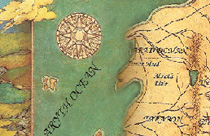Welcome back! Whether you bookmarked, RSS’d, or just wandered in, you’ve arrived at part two of our three-part series where I’ll discuss the maps found in various fantasy-themed worlds.
In case you missed it, you can go here for the first part in the series, where I showcased some maps from a few well-known fantasy novels. For this article, we’ll be exploring the terrains of maps found in some well-known computer games.
Now, at the risk of sounding old and “Get off my lawn“-ish, I’ll state that I believe they just don’t make game maps like they used to. Nowadays every game has an auto-map feature, which is cool, but I kind of miss having a good, hard-core RPG where I’ve got to map my own way. I’ll discuss a few of those games below, but one that comes to mind is the old Wizardry series. I remember playing Bane of the Cosmic Forge as a teenager and being scared out of my pants because I was lost in some dark, digital forest late on Halloween night one year. (I was also probably coming off of a sugar high, which couldn’t have been helping). The only way I could possibly have finished that game was to rely on my hand-drawn maps where every step was meticulously documented. Maybe “kids these days” don’t have the patience. Or maybe I’m just Old School, yo.
Let’s take a look at some maps, shall we?
The Bard’s Tale: Skara Brae?
Now I realize that this fictional town from the 1985 computer game The Bard’s Tale doesn’t register very high on most people’s Lists of Imaginary Places to Visit, and also shouldn’t be confused with the real-world Skara Brae, nor with the one found in the Ultima computer games. But this Skara Brae was significant to me in that it was the setting of the first RPG I ever played on a computer. Each day after school I would whip through my homework and then play Bard’s Tale until Mom gave me that “Okay, that’s enough now” look. (You know the one). When my allotted time was up, I would grudgingly power down and go upstairs to mull over the map included in the game. Let’s take a look:
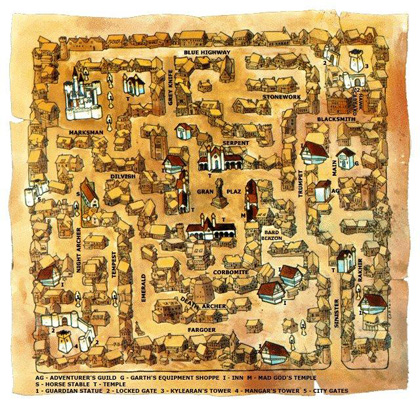
Looks simple enough, right? Perhaps. But man, was I enthralled by the mysteries within. Why are there two towers opposite each other on the corners of the map? How do you get past their gates? Who lives in the castle? Where does Sinister Street, in the southeast portion of the map, lead to? And where is the hidden Review Board, the in-game secret location where your characters could level up? Is there something special about that open area at the end of Fargoer Street?
Like most games of the time, The Bard’s Tale had no auto-mapping feature, and no option to save the game unless you were at a specific location (the Adventurer’s Guild. Look for “AG” on the map). With those two limiting features, I had to oh-so-carefully explore every inch of the city, carefully combing the streets in such a manner as to not get taken out by a roaming band of kobolds or whatever. The farther I went from the AG, the greater my risk increased. Because if your party was wiped out, there was no “Restore Game.” You had to make a new character and have them haul your veteran party to the Temple for resurrection and healing. It terrified me to explore those streets, and I loved every minute of it.
The Ultima series?
If you ever purchased one of the Ultima series computer games, then you know how significant the maps were. Inside the box of each game was a cloth map of the world your adventure took place in. For Ultima II, the map looked like an ancient version of our own planet Earth. For Ultima III (the only Ultima ever made available for my beloved Mac Plus), we received this beauty:
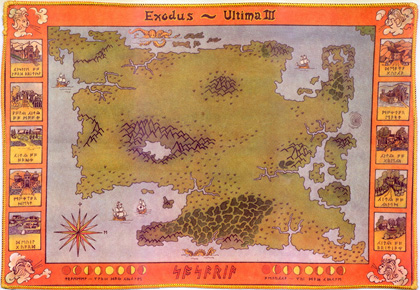
“Sosaria.” That’s a whole continent’s worth of exploring, my friend! For a game released in 1983 on a single floppy disk, that’s pretty darn good. Notice the runes used throughout the map. They happen to be the same ones Tolkien used for Thror’s map. Remember how I spent all that time translating the runes on that one? Well I did the same for this one only to have a strange realization mid-way through my translation: this map didn’t actually show me where the cities were! Today, I have a sinking feeling that I may have marked up my original cloth map with permanent ink as I found the cities within the game. Oh well. It just adds to the charm, I suppose.
The other cloth maps from the Ultima series were all strikingly beautiful. My favorite is the one from Ultima VII:
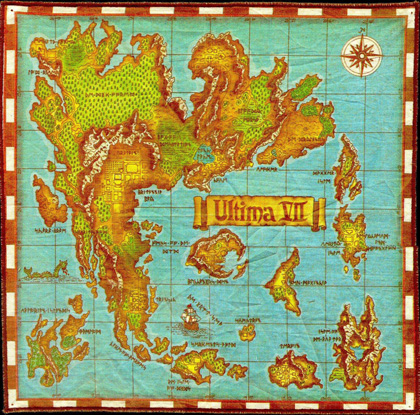
Even though I never owned the game (I didn’t have a DOS computer back then), I remember borrowing this map from a friend just so I could look it over, decipher the runes, and figure out where things were. It was around this time that I began to be able to “read” the runes as if they were regular letters. (Sounds cool, but it was actually just a simple transliteration).
I could be mistaken, but I believe the expansion pack to this game revealed another island located underneath the compass. Was it a cheap marketing trick, or a clever way to introduce new game content? Eh who knows? All I know is that I gobbled up the idea and dreamed about what wondrous lands could possibly be beneath that compass. Terra Incognita indeed!
The Elder Scrolls: Morrowind
The games in Bethesda Game Studio’s Elder Scrolls series: Arena, Daggerfall, Morrowind, and Oblivion, are probably, without question, the largest and most open worlds in computer gaming.
Well, okay. Maybe not. If you don’t count MMORPGs anyway. (There. How’s that? Is that better for all you WoW addicts reading this?)
Potential hyperbole aside, each one of the Elder Scrolls games has a staggeringly huge world that can be explored. I’ve chosen to highlight Morrowind in particular for a few reasons. I’ll explain why in a second. But first, let’s look at the printed map that comes with the base game:
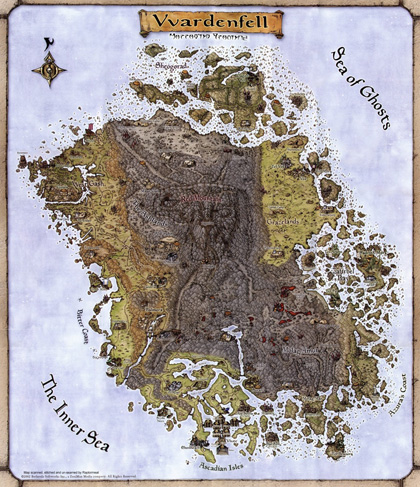
I chose the map of Vvardenfell because Morrowind was the first game in the series to not have randomly generated content. Every inch of the Isle could be explored in-game. See all those tiny dots just off the coast? Those are actually present in the game itself.
Morrowind was so huge that I would play for weeks, get burned out, and set it aside. But time after time I’ve returned to this game, and the reason I do, in each instance, is because I find this map and it calls to me. The game’s main plotline is somewhat lost to me at the moment, but that isn’t what interested me to begin with. I just love wandering the countryside, using this map as a guide, to find hidden caves or help wayward travelers find their lost ring/child/goat/whatever. The greatest compliment I think I can offer the game developers is that my character is somewhere around level 30, and I still haven’t discovered anywhere near the whole isle.
Honorable Mention
Here are some other games that came with great maps:
-
Might and Magic: Each game had a highly detailed map. The World of Xeen maps were probably the most unique, but my heart is with M&M III: The Isles of Terra.
-
Pool of Radiance: The original “Gold Box” game had a plot that was based around clearing an overrun city from monsters, one section at a time. The map of the city in itself was exciting to explore. But when I discovered there were cities and lands to be explored beyond the primary city walls, I was in adventurer heaven.
-
Baldur’s Gate: Both the original and its sequels and expansions had amazingly detailed maps that encouraged exploration and side quests.
Well that does it for this edition! What do you think? What games have you enjoyed that had outstanding maps?
See you next time for our concluding article on fantasy maps!










